Navigate This Post
Thanks to the advent of social(ist) media, we see innumerable “torture tests” week after week. The GLOCK torture test is one of the favorite topics of YouTubers and Instagram models. However, if we could take a moment to analyze the situation, what type of performance should we truly expect from our fighting pistols?
Every handgun is a machine, built by the hands of men. When it comes to handgun testing let’s take a close look at what is practical and what is merely a YouTube fantasy. Before you get your hopes up, no, I will not be throwing a pistol off of a 5th-story balcony or dropping one from a 100 foot crane.
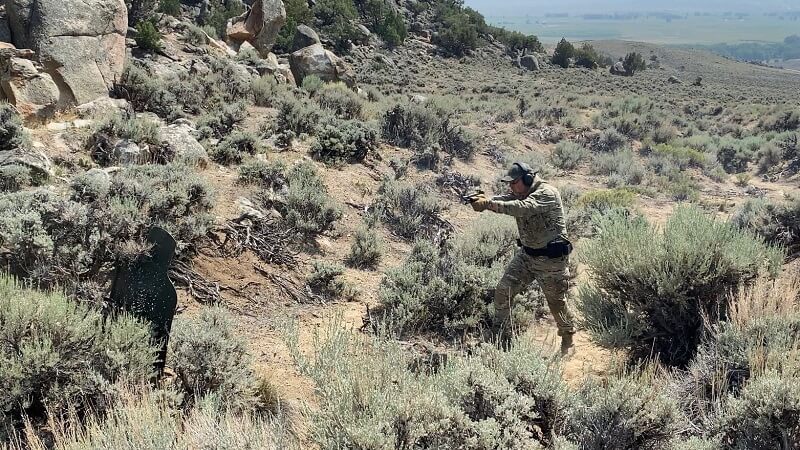
Any handgun “torture test” should be conducted in realistic and practical conditions.
Torture Test on a GLOCK: Reality vs Fantasy.
Help us combat Censorship by joining our Newsletter
While GLOCK pistols are the usual victims of torture testing, thanks to the “Oops, we should have made a tougher trigger” SIG P320 fiasco, YouTube torture test videos are all the rage. Some of the “tests” that people have come up with have gone beyond the ridiculous and sublime.
Hoisting a pistol up a hundred foot crane and letting it free fall, or tossing it off of the roof onto an asphalt parking lot are two of the ludicrous tests that come to mind. Are handgun manufacturers genuinely supposed to make a duty gun that will withstand a hundred foot fall onto concrete? Another fan favorite is to put a pistol in a vice and then whack the back end with a 2×4 to see if the gun will fire.
Are the aforementioned experiments practical or just hype for the YouTube audience? Perhaps we can come up with some genuinely practical testing criteria for duty-style, fighting pistols that we can all legitimately agree upon.
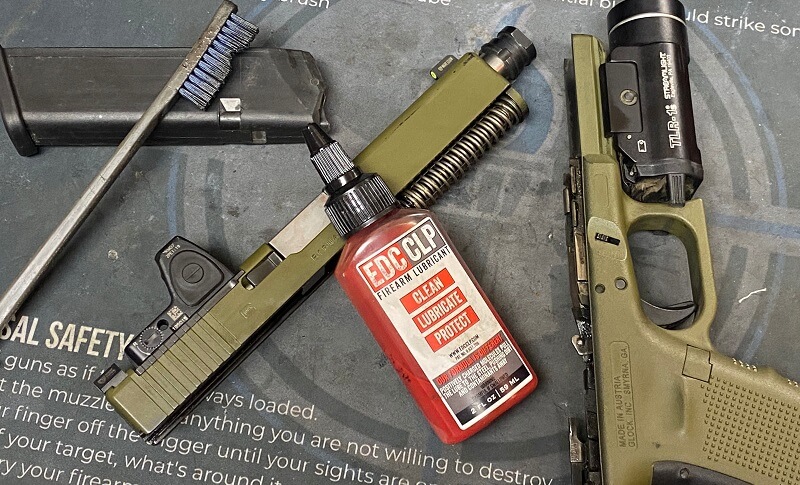
Any legitimate test should begin with the firearm cleaned and properly lubricated.
Anticipated Use of the GLOCK.
I suppose we should begin by adopting the phrase “anticipated use”. What type of hardship or hard field use can we legitimately expect to subject our fighting handgun to? Afterall, the pistol will spend the majority of its life riding in a holster on our hips, not falling off a roof.
Also, firearms are simple machines. A machine has moving parts, and the best machines will operate at peak performance when they start out clean and properly lubricated. I have witnessed torture tests where the torturer deliberately starts out with the gun “dry” and then shoots it to failure. “See, we told you this gun sucks.” Here at Student of the Gun we have been using EDC CLP for a couple of years and are most pleased with its performance.
I have carried a handgun on multiple continents, in cities, jungles, and the desert. The number one hard anticipated use comes from the environment. Despite assertions to the contrary, the Beretta M9 was a tough gun. The Achilles Heel was the open slide that allowed every manner of sand, dirt, and grit to get into the slide. When I deployed to the desert we cleaned our guns, particularly the M9’s, every single day if time allowed.
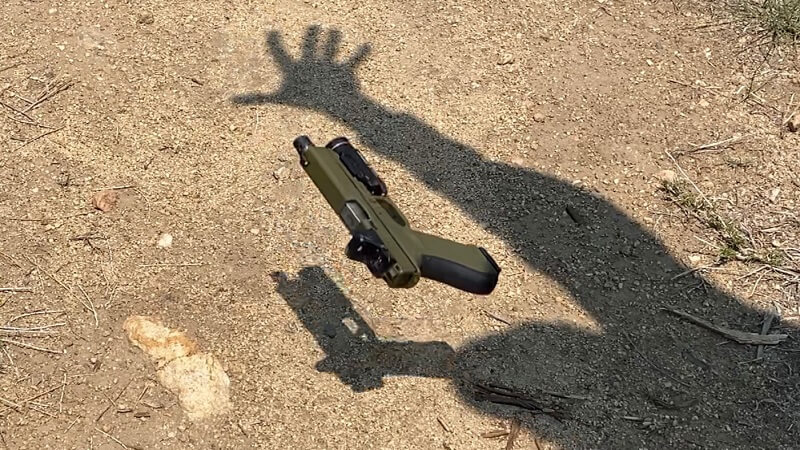
The Drop Test should be done from a realistic height; around 5 feet.
The Drop Torture Test.
One of the favorite torture tests is the drop test. Let’s be serious, the realistic height from which a handgun is likely to be dropped is about 5 feet, not a hundred. Unless you’re Shaq, when you lose control and the gun falls, it will be no higher than about 5 feet or chest level. I don’t know of a reason you would have the gun extended over your head and drop it. Aside from African rebels, not many people fire their guns by holding them up over their heads. And, if for whatever reason you drop it out of a helicopter, you have bigger problems.
Now, the surface onto which the pistol drops is fair game. Concrete, asphalt, hard-packed dirt, mountainous rocks, sand, all of these are normal. The green grass of your KD range is probably the most gentle or forgiving surface onto which a pistol might fall.
As a quick aside, yes, if you lose control of your handgun and gravity takes hold, let that bastard drop. The worst thing you can do is snatch at a gun of which you have lost control. I was once a part of a unit where a man was killed, dead, room temperature, when he snatched a gun that had begun to fall. The pistol had tipped over and his thumb hit the trigger. A 9mm bullet passed straight through his heart. Let loose guns fall.
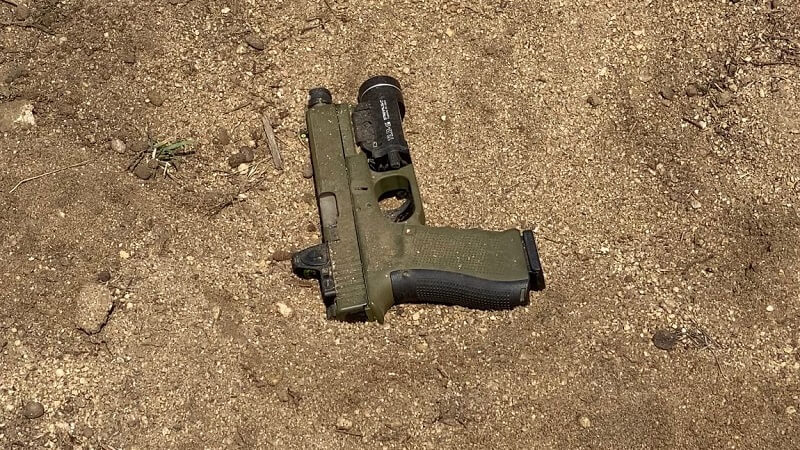
The Buried in Sand Test simulates the grit and dust that might build up on your pistol.
The Dirt / Sand Torture Test
No one expects you to be buried under the sand, ala The Mummy, and then emerge with gun in hand ready to start fighting. However, we do the sand test to amplify or magnify the sand, dust, grit, etc. that are likely to get on the gun while carrying it in a hostile environment.
Do we need to dig a 3-foot-deep hole, bury the pistol, and come back next week to dig it up? I don’t believe so. If you have loose ground, sand, etc. kick a shallow hole with your boot, lay the gun down, cover it with sand until you cannot see it, count to five and then dig it up and test fire. That should be plenty of sand to give you a good indicator as to whether the gun will run or foul up from grit.
You don’t need to dig a 3-foot-deep trench. Also, you do not need to bury the gun for six months. These are not realistic conditions for most duty or fighting pistols.
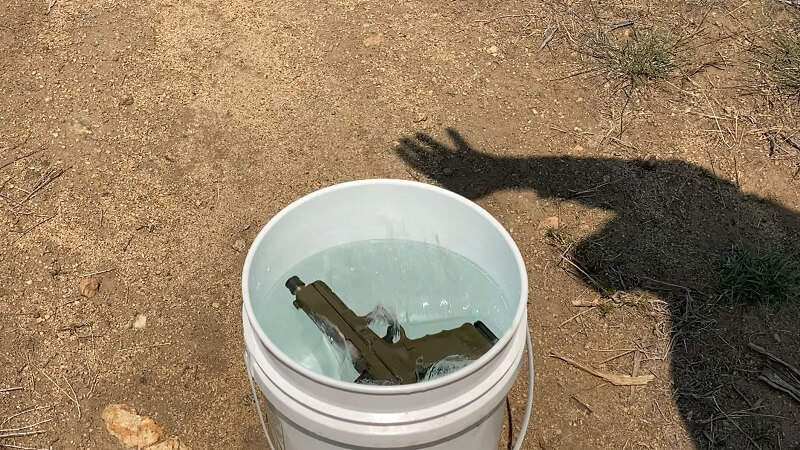
The Water Test can be done with a bucket if you do not have a stream or lake on your range.
The Water Test.
By water torture test I mean the gun is submerged and then fired outside of the water. If you want to shoot your guns underwater, join the SEALS. I cannot think of too many reasons you would be underwater and shooting.
Is it practical to expect a gun that has gone under the water to run after you have given the piece a second or two to drain? To be honest, your ammunition is more susceptible to water damage than your handgun. The red or purple rings around your primers are the water seals that manufacturers of duty ammunition put there deliberately. If you don’t have a river, lake or stream handy with which to immerse your entire body, a five gallon bucket will suffice.
The water test can be conducted by dunking the pistol in the bucket, and pulling it out. Then, shaking it as you are want to do anyway, count to five if you like and attempt to fire. For good measure, empty the magazine, stuff in a fresh one and empty it as well.
If it is the winter, drop the gun in a snowbank and repeat the above steps. I regularly do drop tests in the snow. It makes for an interesting first shot as the snow and ice crystals fly everywhere, but I have yet to have a gun fail from a drop in the snow. At this point, I doubt I ever will.
*Caution: If the gun somehow goes straight nose-down, snow could be in the muzzle. A couple of hard raps with your hand should dislodge it.
*Caution: If your gun goes nose down in mud, there could be a barrel obstruction. It is incumbent for the user to be sure the barrel/muzzle is not packed with mud.
Other Torture Tests.
I know some of you YouTube fans are saying, “freeze it in a block of ice” or “throw it in a fire”. Guys, calm down. Remember, the gun is on your holster. The holster is on your body. Are you planning to submerge yourself in a frozen lake or walk through fire? If so, you have bigger problems than how your pistol is going to behave.
Naturally, all of the above testing methods will apply to any accessory you decide to mount on your fighting handgun. You might find that your tactical light or your new favorite red dot are not as rugged and robust as your pistol. All the better. It is better that you learn about the weaknesses of your light and sight in a testing environment than in the field when you really need them to work.
Also, after you have completed your torture test, now is the time to completely strip your gun. Give it the thorough cleaning that it deserves. You might find it surprising the amount of grit and funk you have built up inside of your handgun just from carrying it around all the time. So, keep your gat-piece clean, yo.
*DISCLAIMER: If you destroy your new red dot or light during this testing, that’s on you. Don’t bother to write us angry letters.
Here at Student of the Gun we are all about the open exchange of ideas. At least, ideas that are not asinine. If you can think of other practical, realistic tests for handguns that do not involve 100 ft cranes or 3rd story balconies, let us know. We’d love to hear them.
Video: Glock Torture Test
Professor Paul Markel
Latest posts by Professor Paul Markel (see all)
- Tactical Masturbation: Top 3 Stupid Human Tricks - July 8th, 2024
- Blood Trail: Fearless Fiction - June 21st, 2024
- SOTG and SB Tactical Celebrate Brace Ruling - June 20th, 2024
- Shotgun Accessories: Practical and Useful - June 14th, 2024
- Tactical Rifle Tips: Transition Drills - January 5th, 2024






Recent Comments